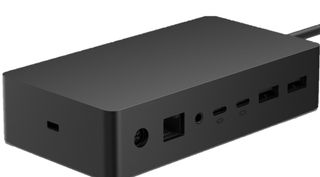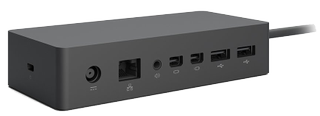Microsoft Surface Dock vs Surface Dock 2: What's the difference?
Old dock or new dock?
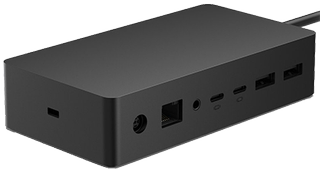
The Surface Dock 2 packs in modern ports, faster speeds, and can power any Surface device.
For
- Has four total USB-C ports
- Supports up to 10Gbps transfer speeds
- Supports higher power delivery (Up to 120W to a Surface device)
- Can drive two 4K displays at 60Hz or two 5K displays at 30Hz
Against
- Only works with newer Surface devices
- More expensive
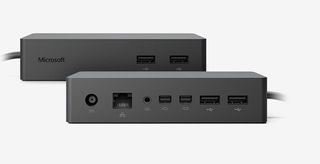
The original Surface Dock still has plenty of ports, but it falls short of the Surface Dock 2 unless you're on older hardware.
For
- Works with older Surface devices
- Has MiniDisplayPorts
Against
- Slower transfer speeds
- Lower resolution cap
- Lower power output can leave devices draining while plugged in
- Expensive for old hardware
The Surface Dock and Surface Dock 2 are accessories that allow you to connect multiple devices and peripherals to your Surface. You can attach devices like keyboards, mice, and webcams and push your Surface device's display output to multiple external monitors.
Both docks also have Ethernet ports, allowing you to have a rock-solid connection to the internet. The device allows you to set up dock a permanent environment with of your devices and accessories and then plug the dock into your Surface using the Surface Connect port.
Specifications
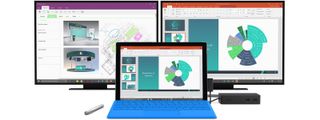
The Surface Dock 2 is a few years old now, but has USB-C ports to work with modern devices, has better charging capabilities, and better support for external displays. It even has a longer cable than the original dock to make it easier to connect your Surface to the dock.
The Surface Dock 2 can power two 4K displays at once at 60Hz or two 5K displays at once at 30Hz. It also has a total power delivery of 199W, and 120 of those watts can charge your Surface device. The remaining 79W can help charge accessories attached to the dock.
In contrast, the original Surface Dock has a much lower set of specs. When pushing to external displays, the original Surface Dock caps at 4096x2160 at 30Hz or 2960x1440 at 60Hz. It also has a lower 90W for power delivery. As a result, the Surface Book 2 can sometimes drain power even while charging.
| Header Cell - Column 0 | Surface Dock 2 | Surface Dock |
|---|---|---|
| USB-C ports | 2x front facing2x rear-facing (video enabled) | No |
| USB-A | 2x rear-facing USB-A 3.2 (Up to 10Gbps) | 4x USB 3.0 (Up to 5Gbps) |
| Ethernet | Gigabit Ethernet | Gigabit Ethernet |
| Audio | 3.5mm audio in/out | Audio out |
| Mini DisplayPorts | No | 2x Mini DisplayPorts |
| Security lock slot | Yes | Yes |
In addition to its better transfer speeds and port selection, the Surface Dock 2 has enterprise management tools that allow admins to allow access to specific sets of ports depending on authentication. Some of the specifications are outlined by Microsoft Mechanics in a video on the Surface Dock 2 if you'd like to see more details.
Compatibility
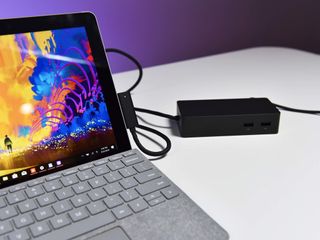
The downside to the Surface Dock 2 is that it only works with certain Surface devices. To use a Surface Dock 2, you need a Surface device made in 2017 or later. Based on this Microsoft support document, the following Surface devices are supported by the Surface Dock 2:
- Surface Book 3
- Surface Book 2
- Surface Pro 8
- Surface Pro 7+
- Surface Pro 7
- Surface Pro 6
- Surface Pro (5th Gen)
- Surface Pro (5th Gen) with LTE Advanced
- Surface Pro X
- Surface Laptop Studio
- Surface Laptop 4
- Surface Laptop 3
- Surface Laptop 2
- Surface Laptop (1st Gen)
- Surface Laptop Go (1st Gen)
- Surface Laptop Go 2
- Surface Go 3
- Surface Go 2
- Surface Go
- Surface Go 2 with LTE Advanced
- Surface Go with Advanced LTE
The Surface Dock 2 improves upon the original Surface Dock in just about every way. It's faster, has more modern ports, can push more resolution to external displays, supports audio in and out, and has more management tools. The Surface Dock 2 is pricey, but it's only $60 more than the original Surface Dock right now.
For that price difference, you're getting quite a few improvements. The only reason to grab an original Surface Dock is if you use an older Surface device that isn't compatible with the Surface Dock 2 or if you need to use Mini-DisplayPorts.
Be sure to check out our roundup of best Surface PCs too!
Which should you buy?
Ultimately, the Surface Dock you should buy comes down to what Surface you have. If you have a Surface that was made in 2017 and up, grab the Surface Dock 2 as you can guarantee full compatibility. If you've got an older Surface, the original Surface Dock will be your best bet.
Get the Windows Central Newsletter
All the latest news, reviews, and guides for Windows and Xbox diehards.

